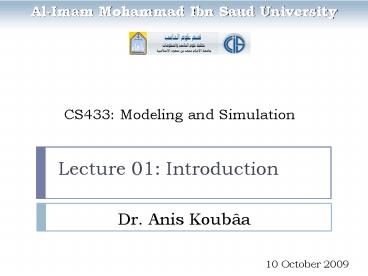CS433: Modeling and Simulation - PowerPoint PPT Presentation
1 / 25
Title:
CS433: Modeling and Simulation
Description:
Research Associate at ISEP/IPP-HURRAY! ( Portugal) Email (Teaching): anis.koubaa.ccis_at_gmail.com ... Main: Wireless Sensor Networks, Cyber-Physical Systems, Real ... – PowerPoint PPT presentation
Number of Views:282
Avg rating:3.0/5.0
Title: CS433: Modeling and Simulation
1
CS433 Modeling and Simulation
- Al-Imam Mohammad Ibn Saud University
Lecture 01 Introduction
Dr. Anis Koubâa
10 October 2009
2
Who I Am?
- Dr. Anis Koubâa
- Assistant Professor at CS Dept.
- Research Associate at ISEP/IPP-HURRAY! (Portugal)
- Email (Teaching) anis.koubaa.ccis_at_gmail.com
- Phone 25 81 921
- Background
- PhD from INPL/LORIA, Nancy (France)
- Master from UHP Nancy I (France)
- My Research
- Main Wireless Sensor Networks, Cyber-Physical
Systems, Real-Time Embedded Systems,
Quality-of-Service, Performance Evaluation - Other Security
3
Teaching Assistant
- Basmah Al-Soli
- Office no. 4034/8
- Office phone 2589128
- E-mail basmah.cs_at_gmail.com
4
Texbook
- Tayfur Altiok, Benjamin Melamed,
- SIMULATION MODELING AND ANALYSIS WITH ARENA
- Hardbound, 456 pages,
- publication date JUN-2007ISBN-13
978-0-12-370523-5ISBN-10 0-12-370523-1Imprint
ACADEMIC PRESS
5
Grading (may be changed)
- Grading Grades will be determined roughly as
follows (Grading may be changed) - One Mid-term, 20 total
- One Final Exam, 40 total
- Project, 20 total
- Lab Exams, 10
- Quizzes and Assignments, 10 total
6
For more information
- Official course website
- http//www.aniskoubaa.net/ccis/cs433/
- All announcements will be posted on the website
- Interaction with students
- Mailing list
- ccis-cs433-spring2009_at_googlegroups.com
- To register
- http//groups.google.com/group/ccis-cs433-fall2009
7
Goals of today
- Understand what is simulation and what is
modelling - Some applications of simulation and modelling
- What is the Life Cycle of the Modelling Process
8
Some keywords to know
- System
- It is a collection of entities that act and
interact together toward the accomplishment of
some logical end (computer, network,
communication systems, etc.) - Simulation
- It is an experiment in a computer where the real
system is replaced by the execution of the
program - It is a program that mimics (imitate) the
behaviour of the real system
9
Some keywords to know
- Model
- It is a simplification of the reality
- A (usually miniature) representation of
something an example for imitation or emulation - A model can be Analytical (Queuing Theory) or by
Simulation. - Performance evaluation (of a system)
- It means quantifying the service delivered by the
System - Experimental, Analytical, or by simulation
10
Examples
Models of the system
Real System (Motherboard)
11
Examples
Simulation models of the system
12
Examples
Models of the System
13
Example
Models of the System
14
What is Simulation?
- ???? ?????????
15
Why we need simulation?
16
Applications of Simulation
17
A few more applications
Flight Simulator
War gaming test strategies training
Transportation systems improved operations
urban planning
Games
Computer communication network protocol design
Parallel computer systems developing scalable
software
18
Computer Simulation
- A Computer Simulation is a computer program
- that attempts to simulate an abstract model of a
particular system. - that describes the behavior of a real (physical)
system and its evolution in time - How it works?
- The behavior of the system is described by state
variables - The simulation program modifies the states
variables to emulate the evolution
19
Why Modeling and Simulation?
20
Performance Evaluation
- ????? ??????
21
Performance Metrics
22
Performance Metrics
- The Performance Metric is a measurable quantity
that precisely captures what we want to measure
(response time, throughput, delay, etc.). - For example, in computer systems, we might
evaluate - The response time of a processor to execute a
given task. - The execution time of two programs in a
multi-processor machine. - In network systems, we might evaluate
- The (maximum/average) delay experienced by a
voice packet to reach the destination - The throughput of the network
- The required bandwidth to avoid congestion
23
What does affect the performance?
- The performance of a system is dramatically
affected by the Workload.
- The Workload it characterizes the
- Quantity e.g. number of cars
- Nature type of cars (cars, trucks, motocycle,
etc.)
24
What does affect the performance?
- In the context of Web Servers, system inputs are
http requests (GET or POST requests). The
workload characterizes - The intensity of the requests how many requests
are received by the web server. High intensities
deteriorate the performance. - The nature of the requests the request can be
simple GET request or a request that require the
access of a remote database. The performance will
be different for different request types.
25
Benchmarks
- Benchmarks used to generate loads that is
intended to mimic a typical user behaviour. - Wikipedia definition
- In computing, a benchmark is the act of running a
computer program, a set of programs, or other
operations, in order to assess the relative
performance of an object, normally by running a
number of standard tests and trials against it. - Benchmarking is usually associated with assessing
performance characteristics of computer hardware - Example the floating point operation performance
of a CPU. - Software benchmarks run against compilers or
database management systems.

